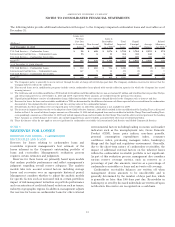American Express 2010 Annual Report Download - page 89
Download and view the complete annual report
Please find page 89 of the 2010 American Express annual report below. You can navigate through the pages in the report by either clicking on the pages listed below, or by using the keyword search tool below to find specific information within the annual report.
RETAINED INTERESTS IN SECURITIZED ASSETS
As of December 31, 2009, the Company retained subordinated
interests in the securitized cardmember loans. These interests
included one or more A-rated, BBB-rated and unrated
investments in tranches of the securitization (subordinated
securities) of $3.6 billion and an interest-only strip of
$20 million. The subordinated securities were accounted for
at fair value as available-for-sale investment securities and were
reported in investments on the Company’s Consolidated
Balance Sheets with unrealized gains (losses) recorded in
AOCI. The interest-only strip was accounted for at fair value
and was reported in other assets on the Company’s Consolidated
Balance Sheets with changes in fair value recorded in
securitization income, net in the Company’s Consolidated
Statements of Income.
NOTE 8
OTHER ASSETS
The following is a summary of other assets as of December 31:
(Millions) 2010 2009
Restricted cash
(a)
$ 4,172 $ 2,192
Deferred tax assets, net
(b)
3,397 2,979
Goodwill 2,639 2,328
Prepaid expenses
(c)
1,802 2,114
Derivative assets
(b)
1,071 800
Other intangible assets, at amortized cost 972 717
Subordinated accrued interest receivable
(d)
—719
Other 1,315 1,364
Total $ 15,368 $ 13,213
(a) Includes restricted cash of $3.7 billion and $1.8 billion, respectively, as of
December 31, 2010 and 2009, which is primarily held for certain asset-
backed securitization maturities.
(b) Refer to Notes 17 and 12 for a discussion of deferred tax assets, net, and
derivative assets, respectively, as of December 31, 2010 and 2009. Derivative
assets reflect the effect of master netting agreements.
(c) Includes prepaid miles and reward points acquired from airline and other
partners of approximately $1.2 billion and $1.3 billion, respectively, as of
December 31, 2010 and 2009.
(d) Upon the adoption of new GAAP on January 1, 2010, subordinated accrued
interest receivable is no longer recorded in other assets and is now recorded
in cardmember loans on the Consolidated Balance Sheets.
GOODWILL
Goodwill represents the excess of acquisition cost of an acquired
company over the fair value of assets acquired and liabilities
assumed. The Company assigns goodwill to its reporting units
for the purpose of impairment testing. A reporting unit is defined
as an operating segment, or a business one level below an
operating segment for which complete, discrete financial
information is available that management regularly reviews.
The Company evaluates goodwill for impairment annually as
of June 30 and between annual tests if events occur or
circumstances change that more likely than not reduce the
fair value of reporting units below their carrying amounts.
The goodwill impairment test utilizes a two-step approach.
The first step identifies whether there is potential impairment
by comparing the fair value of a reporting unit to the carrying
amount, including goodwill. If the fair value of a reporting unit is
less than its carrying amount, the second step of the impairment
test is required to measure the amount of any impairment loss.
As of December 31, 2010 and 2009, goodwill was not impaired
and there were no accumulated impairment losses.
Goodwill impairment testing involves management judgment,
requiring an assessment of whether the carrying value of the
reporting unit can be supported by the fair value of the
individual reporting unit using widely accepted valuation
techniques, such as the market approach (earnings multiples
or transaction multiples) or income approach (discounted cash
flow methods). The fair values of the reporting units were
determined using a combination of valuation techniques
consistent with the income approach and the market approach.
When preparing discounted cash flow models under the
income approach, the Company uses internal forecasts to
estimate future cash flows expected to be generated by the
reporting units. Actual results may differ from forecasted
results. The Company uses the expected cost of equity
financing, estimated using a capital asset pricing model, to
discount future cash flows for each reporting unit. The
Company believes the discount rates used appropriately
reflect the risks and uncertainties in the financial markets
generally and specifically in the Company’s internally
developed forecasts. Further, to assess the reasonableness of
the valuations derived from the discounted cash flow models, the
Company also analyzes market-based multiples for similar
industries of the reporting unit, where available.
87
AMERICAN EXPRESS COMPANY
NOTES TO CONSOLIDATED FINANCIAL STATEMENTS
























